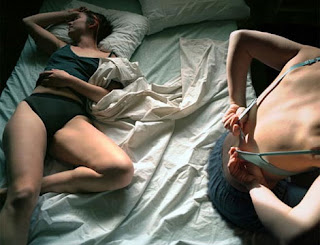Fried's discussion of the Wittgenstein in chapter three, specifically "disinterestedness", finally names what I have been seeing in some contemporary photography. A disinterested, or "cool" point of view, sterile. Examples:
 |
| Image from Alec Soth's Niagra |
 |
| Image from Brian Ulrich's Copia |
 |
| Image from Matt Siber's Floating Logo series |
Fried and Wall comment on the wetness and dryness of the photographic medium. Water creates and destroys in photography. In film processes, liquid chemicals make the latent image appear, yet if the camera comes into contact with water, especially electronic cameras, they are ruined. Water is primordial and symbolic, but the "inherent coolness" of the photographic medium can make sterile images. I see a lot of photographers with little emotion, or "wetness", in their images. These are only a few examples, but here are some contemporaries to compare to:
 |
| April 2004, from Paul D'Amato's We Shall series |
 |
| From Terry Evans' Canada to Texas series |
 |
| From The Dog and The Wolf series by Laura Letinsky |
But is photography itself inherently cool? Compared to what? Painting? And is it sterile or disinterested because of the mechanics and the science of it? That starts to sound like early arguments against photography as art, when it was used to document "truth" (which some people still believe) and since it it used a mechanical device it wasn't valid as an artistic medium. Wall and Fried say that these, wetness and dryness, are at play in photography. Maybe a balance between the two is what makes successful photographs. What about those that aren't using photography in the sense that we have come to know it? I feel like the further away we get from the "inherent coolness" of photography, really the further we get away from making perfect images, I think the more wetness is put back into the medium, especially in this digital age. Wetness to me is emotion or the indescribable. Here are some current photographers that are working outside of what photo students are taught (especially at Columbia) is the perfect print/photo/whatever:
 |
| by Curtis Mann |
 |
| by Curtis Mann |
 |
| by Ryan McGinley |
 |
| by Ryan McGinley |
 |
| by Ryan McGinley |
I may come back and postulate on the inherent coolness of photography later, but as for now, on to the everyday.
Fried titles this chapter "They Everyday" and yes, the everyday is everyday until it is made into a work of art and then it is the looking at life as it's happening and seeing it as "God's masterpiece." Why is this? Well, Fried doesn't really explain, he just kisses Jeff Walls ass some more and I'm tired of reading about how brilliant the man is, can we use some other examples Fried? Anyways these are the things I got from Fried:
Composition and light have a lot to do with making the everyday less "everyday"... DUH.
He compares Wall's photos to Elinga (and really Vermeer) paintings, people absorbed in their daily activities, which would otherwise be dull, except he light and composition make it visually appealing and we read into the image more. This is the same with Wall's Window Cleaning, without the light an composition (and arguably the historical context of the building), the image would just be an "insipid photograph" that might have meant something to the artist at the time, but does not translate to others.
This idea is interesting, the "insipid photograph of a piece of scenery which is interesting to the person who took it because he was there himself, but which to a third party looks at with justifiable coldness; insofar as it is ever justifiable to look at something with coldness," a quote from Wittgenstein. Is this why we don't like looking at other peoples vacation pictures? Because we didn't experience it ourselves? Then if we have never experienced something in an image, can we not relate to the photograph? Take Brian Ulrich's Copia image above, if we had never been into a Target, or any massive retail store before, would be be able to get its humor? I think not. So no one has ever noticed the light on their wall at x time of day, then do they understand Uta Barth's light studies? Uta Barth is also an excellent example of the everyday and that once it becomes a work of art, it transcends the "everyday".
 |
| Uta Barth and to draw a bright white line with light |
Fried also mentions "a common place about photography...is that it depicts surfaces and traces on surfaces,"which it undeniably does. This is interesting, but I can't wrap my brain around what this could mean...is it bad? Does it matter?
Then there is an image from Wall (again!), on page 87, that establishes itself as resistant to being beheld, which is another interesting idea. What does it mean to be beheld? Who hold the power in that situation, the object or the viewer, the looker or the looked at? If this image is resistant to being beheld, because of it's darkness and close tonal values, then the content of the image, logically, is also resistant to being beheld. Fascinating! I love it when the actual artwork object and the medium and the way the print comes out or the materials used reflect what the actual content or subject matter of the work.
Things I'm still thinking about and will probably post about later:
Unaware of being beheld
Voyeurism?
Blindness
Blind from within
Resistant to being beheld
Staged
Theatrical
Performed
Antitheatrical motif= subject walking away from viewer









